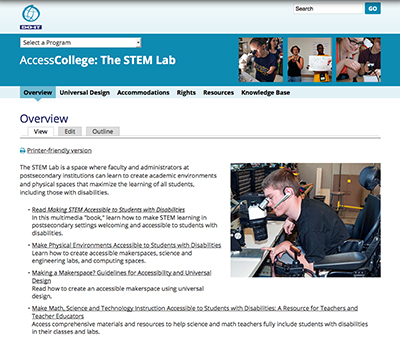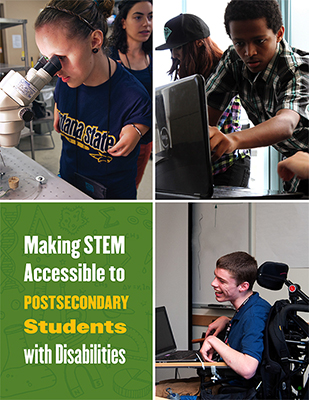AccessSTEM Resources Promote Change

Postsecondary students with disabilities have the right to equal access on all aspects of campus life. As increasing numbers of people with disabilities participate in science, technology, engineering and mathematics (STEM) programs, the accessibility of classes, services, libraries, computers, science labs, electronic resources, events, and information technology increases in importance. The AccessSTEM project has created resources for educators to use to increase access to STEM environments.
The STEM Lab website is a space where faculty and administrators at postsecondary institutions can learn to create academic environments that maximize the learning of all students, including those with disabilities. Content offered within the STEM Lab includes the following:
- A multimedia book, Making STEM Accessible to Postsecondary Students with Disabilities.
- Resources for making physical environments accessible to students with disabilities, including makerspaces, science labs, and computing spaces.
- The video Equal Access: Universal Design of an Academic Department.
- Guidelines for accessibility and universal design (UD).
- Comprehensive materials for teachers and teacher education programs.
- Information about accessible science equipment.
- Examples of students with disabilities succeeding in STEM careers.
- Links to videos, publications, and websites that promote accessible STEM education.
New resources will be added to The STEM Lab regularly, so continue to check back for updated information or visit the AccessSTEM homepage for more resources. Details about some of the resources on this site are included in the paragraphs that follow.

Making STEM Accessible to Postsecondary Students with Disabilities is an online multimedia book that pulls together resources that are useful to educators and administrators who strive to make STEM welcoming and accessible to students with disabilities. This includes computing facilities, science and engineering labs, classrooms, makerspaces, online resources, curriculum, and instruction. Highlighted strategies are easy to implement when designing STEM facilities or instructional practices, while others are more difficult but will yield long-term results (e.g., changing the culture of a STEM department to be more inclusive of individuals with disabilities). Although focused on postsecondary institutions, most of the content in this publication is relevant to K-12 STEM courses, labs, and programs as well.
The 10-minute video, Equal Access: Universal Design of an Academic Department, focuses on creating an accessible academic environment for all students to participate in. Using principles of UD, anyone can make their department welcoming and inclusive. UD follows the philosophy that all products and environments should be designed to be used by all people to the greatest extent possible. Rather than design departmental offerings for the average user, design them for people with a broad range of abilities, disabilities, ages, reading levels, learning styles, native languages, cultures, and other characteristics. This video showcases the many strategies and reasons to apply UD to your academic department. A complementary publication to this video can be found online.